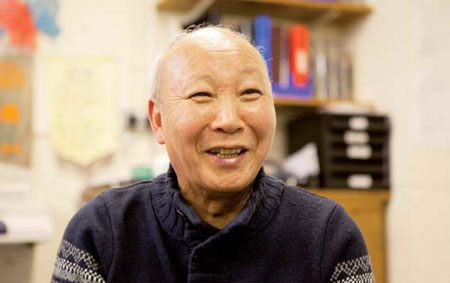Changing Chinatowns
Updated: 2012-11-16 08:48
By Cecily Liu (China Daily)
|
||||||||
Su is just one of the generations of Chinese diaspora, who have grown up with good education and ambitious dreams, and are also part of the new generation who are heralding change.
|
Li Kui-hsuing is founder of Pagoda Arts, a Chinese community center in Liverpool. Zhang Bin / China Daily |
|
Kelly Su, 18, is a music teacher at Pagoda Arts who came to Liverpool eight years ago with her family. Zhang Bin / China Daily |
|
Chinese photographer Mike Tsang showcased the exhibition Between East and West in London. Provided to China Daily |
Early days
Chinese immigrants started coming to UK in a big way in 1866 after the Blue Funnel Shipping Line started regular steamer services between Shanghai and Liverpool for shipping silk, cotton and tea from Shanghai to Liverpool.
The early migrants stayed in the boarding houses set up by the shipping company in Liverpool, which later became the cornerstone of the first Chinatown in Europe. Though many of these settlers started their own businesses they maintained a low profile due to their low social status. Wages paid to these Chinese workers were often far lower than those paid to the average English worker.
The humble collection of dwellings soon transformed into a sprawling town as more visitors and immigrants started coming from China.
In 1945 more than 1,000 Chinese seamen were repatriated against their will, of whom more than 200 had married British women, and hence had legal rights to stay.
Though a plaque erected at the Pier Head in Liverpool indicates that such incidents would not be allowed to happen again, the second and third-generation Chinese migrants feel that, unlike their predecessors, it is important for the community to make itself known and heard.
It is precisely this ethos that have led to the establishment of the Liverpool Chinese Business Association in the 1990s, initially to combat street crime in Chinatown. "Liverpool's Chinatown area experienced a high level of car crimes in the 1990s, because the surrounding areas were residential, and lots of children had nothing to do," says Alan Seatwo, the current chief coordinator of the LCBA.
What the LCBA has done is to give Chinatown and the Chinese community a voice that can be heard, he says. "We have given the community a focus and worked with local police and social service providers to solve many problems encountered by Chinese restaurants, shops and supermarkets," he says.
The LCBA also worked with the Liverpool government to facilitate a twinning arrangement between Shanghai and Liverpool to rekindle the past ties between the two cities. To commemorate this twinning, Liverpool's Chinatown received an arch made in Shanghai and transported to the UK piece by piece in 2000.
"The twinning with Shanghai has captured the city's imagination," Seatwo says. With 200 dragons engraved onto the marble arch coated in a mixture of gold, red, green and yellow, the arch has became a symbol of Liverpool's Chinatown, and put it on the tourist map.
LCBA, which is staffed by volunteers, has risen to be an important business body in Liverpool by providing advisory services to many British businesses keen on expanding linkages in China.
"We also helped the Liverpool government set up an exhibition area during the 2010 World Expo in Shanghai. As China's economy grows, its links with British businesses will also grow, and we are very proud to be a bridge between the two," he says.
Seatwo initially came to Liverpool in 1987 to study advertising at Liverpool John Moores University. "Back then, everyone in the Chinese community worked in takeaway restaurants."
To support himself financially, he worked part-time at a Chinese restaurant. Finishing university classes at 4.30 pm, he would typically work from 5 pm till almost midnight.
"It gave me an opportunity to learn first-hand the concerns of Chinese restaurant owners, and that's why I feel so strongly about helping them move forward," he says, adding that he devotes the same amount of time to the LCBA as he does to his regular job as an e-learning designer at Edge Hill University.
One of the projects he helped initiate in cooperation with the Liverpool local government two years ago was the Eat Right, a certification given to restaurants that reduce the amount of salt and monosodium glutamate used in cooking. It was intended as a way to help Chinese restaurants adapt to the demands of increasingly health-conscious British consumers.
"Chinatown's restaurants need help to stay competitive in today's market, but they also need to change their mindset and improve the quality of their food and services," Seatwo says, adding that some of the changes to food quality are already being embraced enthusiastically.

 Relief reaches isolated village
Relief reaches isolated village
 Rainfall poses new threats to quake-hit region
Rainfall poses new threats to quake-hit region
 Funerals begin for Boston bombing victims
Funerals begin for Boston bombing victims
 Quake takeaway from China's Air Force
Quake takeaway from China's Air Force
 Obama celebrates young inventors at science fair
Obama celebrates young inventors at science fair
 Earth Day marked around the world
Earth Day marked around the world
 Volunteer team helping students find sense of normalcy
Volunteer team helping students find sense of normalcy
 Ethnic groups quick to join rescue efforts
Ethnic groups quick to join rescue efforts
Most Viewed
Editor's Picks

|

|

|

|

|

|
Today's Top News
Chinese fleet drives out Japan's boats from Diaoyu
Health new priority for quake zone
Inspired by Guan, more Chinese pick up golf
Russia criticizes US reports on human rights
China, ROK criticize visits to shrine
Sino-US shared interests emphasized
China 'aims to share its dream with world'
Chinese president appoints 5 new ambassadors
US Weekly

|

|









